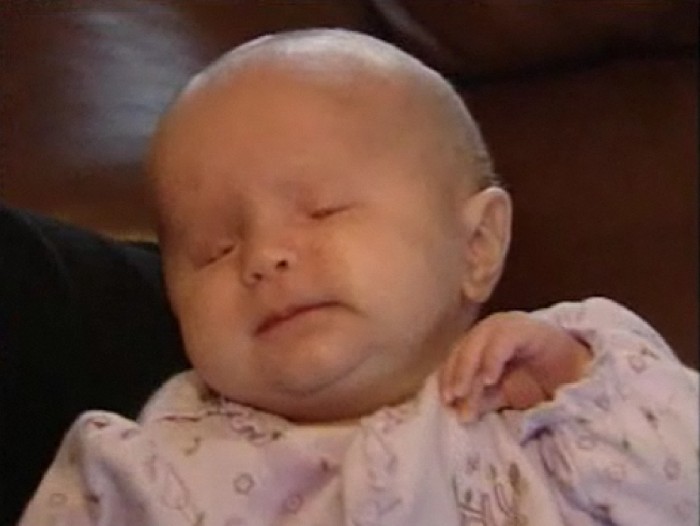Bilateral Anophthalmia: Understanding The Rare Condition Of Babies Born Without Eyes

Table of Contents
Causes and Genetic Factors of Bilateral Anophthalmia
The precise causes of bilateral anophthalmia remain complex and not fully understood. However, a significant role is played by genetic factors. Several gene mutations have been linked to this condition, with PAX6 and SOX2 being prominent examples. These genes are crucial for the development of the eyes during embryonic development. Mutations in these genes can disrupt the intricate processes leading to eye formation, ultimately resulting in anophthalmia.
While genetic factors are predominantly implicated, the contribution of environmental factors cannot be entirely ruled out. The interplay between genetic predisposition and environmental triggers likely contributes to the etiology of bilateral anophthalmia. Further research is needed to fully elucidate this complex interaction.
- Key genes implicated: PAX6, SOX2, and others still under investigation.
- Inheritance patterns: Bilateral anophthalmia can exhibit various inheritance patterns, including autosomal recessive, autosomal dominant, and X-linked inheritance, depending on the specific gene involved. Genetic counseling is essential for families affected by this condition.
- Etiological complexity: Multiple factors frequently interact to cause bilateral anophthalmia, highlighting the need for comprehensive research.
Diagnosis and Prenatal Detection of Bilateral Anophthalmia
Early diagnosis of bilateral anophthalmia is paramount for parental preparation and planning. Prenatal detection is possible through ultrasound examinations during pregnancy. Ultrasound scans can reveal the absence of ocular structures, providing a strong indication of anophthalmia. Furthermore, genetic testing may be utilized to identify specific gene mutations associated with the condition. However, genetic testing isn't always conclusive, and results may be inconclusive in some cases.
Postnatal diagnosis involves a thorough ophthalmological examination to confirm the absence of eyes. The assessment may also include other tests to rule out associated conditions. Collaboration between ophthalmologists and geneticists is crucial for accurate and comprehensive diagnosis.
- Typical ultrasound findings: Absence of ocular structures, abnormal facial features in some cases.
- Genetic testing: Identifies specific gene mutations associated with bilateral anophthalmia, though results aren't always diagnostic.
- Role of specialists: Ophthalmologists and geneticists play vital roles in the diagnostic process and subsequent management.
Living with Bilateral Anophthalmia: Challenges and Support
Living with bilateral anophthalmia presents unique developmental, social, and emotional challenges. Early intervention is critical to address these challenges effectively. This includes specialized therapies and support services tailored to the individual's needs. Assistive technologies play a significant role in enhancing independence and quality of life. These include prosthetic eyes (ocular prostheses) for cosmetic purposes, and sensory aids to compensate for the lack of sight.
The psychological and emotional well-being of both the individual and their family is paramount. Support groups and organizations provide invaluable resources and a network of understanding.
- Support groups and organizations: Connecting with others facing similar challenges can provide emotional support and practical advice.
- Early intervention programs: These programs are crucial for promoting development and adapting to the challenges posed by bilateral anophthalmia.
- Types of prosthetic eyes: These can improve appearance and contribute to a better sense of self-esteem.
- Fostering independence and social integration: Strategies such as specialized education, assistive technology, and social skills training are essential.
Treatment Options and Future Perspectives for Bilateral Anophthalmia
Currently, there's no cure for bilateral anophthalmia. Treatment focuses on improving quality of life, enhancing independence, and addressing associated challenges. This may include prosthetic eye fitting, sensory integration therapy, orientation and mobility training, and psychosocial support. Ongoing medical care and regular check-ups with specialists are crucial for monitoring development and managing any associated health concerns.
Research into bilateral anophthalmia is ongoing, with promising avenues being explored. Gene therapy holds the potential for future treatments, though significant challenges remain.
- Current surgical options: Surgical interventions are primarily focused on improving the fit and comfort of prosthetic eyes or addressing associated facial features.
- Promising areas of research: Gene therapy and stem cell research are offering potential pathways for future treatment.
- Regular check-ups: Ongoing monitoring by specialists is vital for overall health and well-being.
Conclusion: Understanding and Supporting Individuals with Bilateral Anophthalmia
Bilateral anophthalmia is a complex condition impacting development and well-being. Understanding its genetic basis, enabling early prenatal diagnosis, and providing comprehensive support services are crucial for improving the lives of affected individuals and families. Early intervention is key to fostering independence, maximizing potential, and promoting a positive quality of life. Continued research into the causes and potential treatments for bilateral anophthalmia is essential. Learn more about managing bilateral anophthalmia, support research funding for bilateral anophthalmia, or find support for bilateral anophthalmia through dedicated organizations and support groups.

Featured Posts
-
 Sato Joins Indy 500 Field 34 Entries Confirmed For Race
May 12, 2025
Sato Joins Indy 500 Field 34 Entries Confirmed For Race
May 12, 2025 -
 Max Greenlights Future Projects In The Crazy Rich Asians Universe With Jon M Chu
May 12, 2025
Max Greenlights Future Projects In The Crazy Rich Asians Universe With Jon M Chu
May 12, 2025 -
 Whos Injured Rays Vs Yankees Series Breakdown April 17 20
May 12, 2025
Whos Injured Rays Vs Yankees Series Breakdown April 17 20
May 12, 2025 -
 Tonights Ufc 315 A Complete Guide To The Event
May 12, 2025
Tonights Ufc 315 A Complete Guide To The Event
May 12, 2025 -
 End Of Outings Fabers New Policy On Refugee Activities
May 12, 2025
End Of Outings Fabers New Policy On Refugee Activities
May 12, 2025
